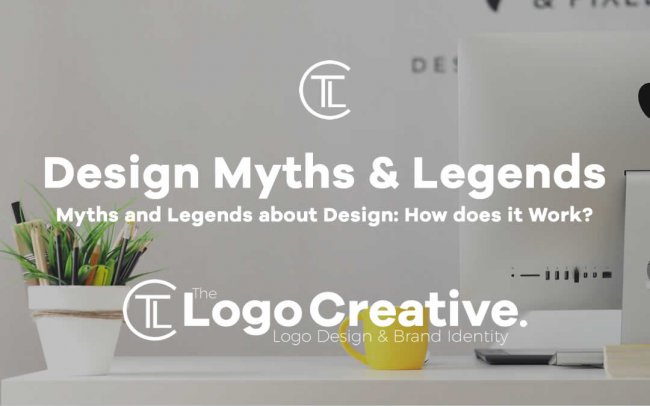Design has existed for a very long time and over time, it has racked up a lot of myths and legends which have continued to exist even till now even though they are not quite true. The word design is all about the creation of something, be it an object or a system. You can design many things, clothes, products, identities, business processes, user interfaces, websites, etc. In this article we discuss Myths and Legends about Design: How does it Work?
Design can be formally defined as the creation of something using some components or raw materials by an agent (named designer) to solve a particular problem based on some rules or requirements. In other words, a designer creates something from scratch following certain rules.

This is a very fitting definition that recognizes that designs are usually created to solve a particular problem. For example, a graphically designed flyer is meant to inform people about something like an event in an attractive way. User interfaces are usually designed to give the user an easy, yet unique user experience and the interior design of homes are done to improve the functionality and look of that home space.
However, there are many myths and legends about design that tend to hurt not just designers but also businesses that take them seriously. This is why it is better to debunk at least, some of these myths. You’ll find it interesting to discover the facts behind the following myths and legends.
Table of Contents
Design is the same thing as art
There are many debates about whether design is considered to be art or science among designers from different fields of study. This is because there are many different approaches to design based on the field of study. People in the art field of study (e.g. Graphic designers and painters) view design from the visual arts perspective while people in the engineering field of study (e.g. product designers) view design from the scientific perspective of design as an applied science to final products.
But based on the definition of design by Professor Nigel Cross, we can understand that design includes both science and art. While art is used to make a product attractive and display its best features, science is used to make the product functional.
Design is a tool
Many people, especially learning designers have developed a belief that when they know how to use a design tool like Adobe Illustrator or Adobe Photoshop, they are Design Pros and ready to take on any design project. But design cannot be based on this narrow perspective because it involves a process that takes ideas through stages of critical thinking and prototyping till an end result design is produced.
As such, design is considered a process rather than just a tool. It involves a process called the design thinking process which starts from understanding the problem to getting ideas, to creating prototypes to test the problem-solving ability, durability and market-fit of the design and then creating the final product.
Aesthetics is another word for design
Many people see design as the creation of beautiful images, paintings, and interfaces. But design is much more than beauty and aesthetics, in fact, design is concerned with form and function. Design is concerned with how we perceive what has been designed and how it looks (form) and how the product works or can be used (function).

A product with great form but no function will be useless and one with function and no form will be useful but unattractive. Without a good balance, designed products will not have a good market fit. We can take Apple as an example of a company which takes design form and function seriously as seen from their products.
Designers don’t need a degree
Many people believe that design is something that can easily be learned at home, on the internet via a few eBooks and videos teaching about design or design tools. But design is much more than that.
A good place to start is online learning through Skillshare they offer 2 months unlimited online learning for a small monthly fee and the courses on there are delivered from the worlds best talent even some designers that have been interviewed by The Logo Creative themselves.
Even though it does not have to involve a full track education, there are certain requirements for a designer’s education: design theories, design principles, design implementation, etc.

For a designer to persevere in any design environment of his/her chosen design niche (Painting, Product design, etc.), he or she must have a full knowledge of design. Which is why even though designers might not need a degree, they do need a design education.
Designers are untidy and unaware people
You’ve probably heard it somewhere or seen it portrayed in the media, usually targeted at creative designers in the visual arts niche, the belief that designers are day-dreaming messy people who are too unaware of their environment to bother with cleaning themselves.

This might be true for some people in the profession but not all. Imagine a sketch artist who sketches and has clients and deadlines who then scatters his materials all over. He is bound to be slow and unable to keep up with deadlines when he is searching for a particular pencil or crayon or tool.
Many people have a designing ability and dream, in order for a designer to achieve their dreams, they can’t afford to be messy or less than tidy to retain their creativity, clients and speed.
Designers cannot work in teams
Although this depends on different people, it is not completely impossible for designers to work in teams. Yes, there are people who can produce the best results when they work alone without anyone interrupting, but there are also people who can work in a team.

Being a team does not mean getting different people to sit in an office in different cubicles staring at their different computer screens, it means different designers coming together to share ideas and brainstorm. From practice, AssignmentMasters said ,“effective teamwork is much more productive, faster and enhances every individual’s skills in the team”.
Conclusion
Regardless of all these myths and legends, design is different for everyone. In fact, design is all about individuality not just from the designers’ end but also from the viewers’ end. As such, while some myths can work for describing certain designs or designers, they cannot apply to everyone and some of them are just plain wrong which is why we need to develop a clear and objective understanding of design.
We hope you have enjoyed this article about Myths and Legends about Design: How does it Work?, and be sure to leave us a comment we love hearing from our readers.
Useful Links & Great Deals
- The Equipment We Use & Recommend
- Quality Design Bundles
- Get 2 Months free Skillshare
- Get an Exclusive 20% off Logo Package Express
- Learn Logo Design Online
 Author bio
Author bio
Sara Williams is an editor, journalist, writer from San Jose. She likes to read the world classics, traveling, to engage in yoga. Almost all her spare time is spent reading.


